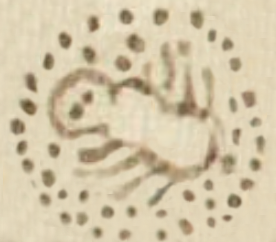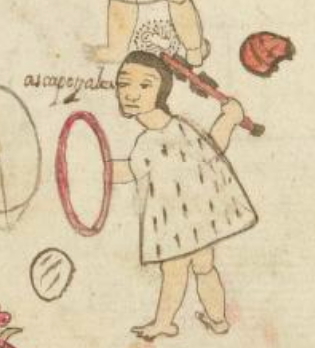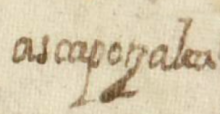Azcapotzalca (Azca16)
This black-line drawing of the compound glyph for the ethnicity Azcapotzalca, the people of Azcapotzalco, doubles as the place name. It shows a bird’s eye view of a circular group of what may be sand particles, such as what might be made at the site of an ant (azcatl) hill or mound (potzalli). Note how the ant that appears here has what appear to be eight legs. This is also the case in Image 7 of the Azcatitlan Codex.
Stephanie Wood
Part of this glyph was obscured by nearby objects, so we have recreated part of the sandy mound areas. Note how the glyph for Azcapotzalca (the people) is similar in content and design to the place name, Azcapotzalco (below).
Stephanie Wood
ascapotzalca
Azcapotzalca
Stephanie Wood
post-1550, possibly from the early seventeenth century.
Jeff Haskett-Wood
hormigas, montículos, ethnicidades

azca(tl), ant, https://nahuatl.wired-humanities.org/content/azcatl
potzal(li), mound, hil), https://nahuatl.wired-humanities.org/content/potzalli
-ca and -catl (ethnic suffixes, plural and singular), https://nahuatl.wired-humanities.org/content/catl
gente de Azcapotzalco
Stephanie Wood
The Codex Azcatitlan is also known as the Histoire mexicaine, [Manuscrit] Mexicain 59–64. It is housed in the Bibliothèque Nationale de France, and hosted on line by the World Digital Library and the Library of Congress, which is “unaware of any copyright or other restrictions in the World Digital Library Collection.”
https://www.loc.gov/resource/gdcwdl.wdl_15280/?sp=16&st=image
The Library of Congress is “unaware of any copyright or other restrictions in the World Digital Library Collection.” But please cite Bibliothèque Nationale de France and this Visual Lexicon of Aztec Hieroglyphs.






